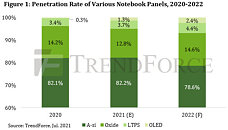
LG Display Reports First Quarter 2025 Results
LG Display today reported unaudited earnings results based on consolidated K-IFRS (International Financial Reporting Standards) for the three-month period ending March 31, 2025.
- Revenues in the first quarter of 2025 decreased by 23% to KRW 6,065 billion from KRW 7,833 billion in the fourth quarter of 2024 and increased by 15% from KRW 5,253 billion in the first quarter of 2024.
- Operating profit in the first quarter of 2025 recorded KRW 33.5 billion. This compares with the operating profit of KRW 83.1 billion in the fourth quarter of 2024 and with the operating loss of KRW 469 billion in the first quarter of 2024.
- EBITDA profit in the first quarter of 2025 was KRW 1,231 billion, compared with EBITDA profit of KRW 1,306 billion in the fourth quarter of 2024 and with EBITDA profit of KRW 810 billion in the first quarter of 2024.
- Net loss in the first quarter of 2025 was KRW 237 billion, compared with the net loss of 839 billion in the fourth quarter of 2024 and with the net loss of KRW 761 billion in the first quarter of 2024.








